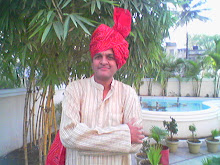
Silver foil, or varakh, as it is generally known in India, adds glitter to Indian sweets, betel nut (Supari), Paan (betel-leaf), and fruits. It is also used in Ayurvedic medicines. The silver-topped sweet is even served as prashad in many temples and on auspicious and religious occasions. Varakh is also used in flavoured syrups as in Kesar (saffron) syrup.
If one observes Varakh under a microscope one will find traces of blood, stools and saliva of a cattle or an ox. Varakh is not derived from an animal source. However, a crucial material of animal origin, ox-gut, is used in its manufacture. This ox-gut is obtained from the slaughterhouse.
The intestine (ox-gut), smeared with blood and mucus, is pulled out from the slaughtered animal by the butcher at the slaughterhouse, and sold for the specific purpose. This is then taken away to be cleaned and used in the manufacture of Varakh.
The gut of an average cow, measuring 540 inches in length and 3 inches in diameter, is cut open into a piece measuring 540" x 10". From this, strips of 9" x 10" are cut to give approximately 60 pieces of ox-gut, which are then piled on top of each other and bound to form a book of 171 leaves.
Next, small thin strips of silver are placed between the sheets and the book slipped into a leather pouch. These bundles are hammered continuously for a day to produce extremely thin foils of silver of 3" x 5".
The leather and ox-gut, being supple, can withstand the intense manual hammering for up to 8 hours a day till such time as the silver is beaten to the desired thickness. When ready, the foil is carefully lifted from between the leaves of ox-gut and placed between sheets of paper to be sold to the sweet shops. A booklet of 160 foils weighs approximately 10 grams and costs few hundred rupees.
Silver is considered precious and its utility is enormous. The reason behind this is that silver reflects back 95% of the light energy that falls on it. The silver foils used for edible purposes is called VARAKH So what's so special about VARAKH? If you keenly observe this VARAKH under a microscope don be perturbed if you happen to see traces of blood, stools and saliva of a cattle or ox.
VARAKH is a silver foil and we have no second questions on this, but to prepare this VARAKH important parts of the CATTLE/OX is made use of.
Intestines of Cattle/OX are obtained from the slaughterhouse. This is obtained after butchering to death the cattle/ox for beef and the part, which cannot be consumed: the intestines are pulled out of the animal and handed over to the manufacturers of VARAKH. Before handing over the intestines, they are washed in the slaughterhouse to get rid of the blood and other remains on these intestines in the limited facility that is present in the slaughterhouse. We are not sure how neatly this job is carried out. Intestines are cut into small pieces and then are bound together as pages in a notebook.
A silver block is placed in the middle of these bound intestines, and the whole thing is placed in a leather bag and sealed. Experts, who know how to make VARAKH, pound the bag with wooden sticks, till the entire bag flattens out. The silver block would by this time be turned into silver foil. This Silver foil would now be separated from the intestine pack and will be placed on paper.
This is VARAKH, which reaches the market ready for use. Even staunch vegetarians, who shy away from egg, unknowingly consume this as a part of sweet, pan and arecanut. Some unknowingly consume this because of the additional taste that VARAKH provides.
Now the question is "Why the intestines of the cattle/ox? Why not something else?" The reason behind using the intestines of the cattle/ox for preparing the VARAKH is because of the elasticity of the intestines. They do not get cut even after a severe pounding.
To make a single booklet of 171 sheets, the guts of 3 cows are used. And the yield per book is generally 160 foils of silver, the rest of which may be damaged or unfit for use. Thus one book, used on an average of 300 days of the year yields approximately 48,000 foils of silver which means that each ox-gut yields an estimated 16,000 foils.
he leather used for the pouch to hold the book (made from ox-gut), is cowhide or calf leather, and uses about 232 sq. inches of material. Assuming the size of an average cowhide to be 18 sq. ft or 2,600 sq. Inches, the yield per hide will be approximately 10 leather pouches.
Usually 4 foils are used per kilograms of sweets and the ox-gut of one cow is used to produce foil for approximately 4,000 kilograms of sweets. It is estimated that the average consumption of sweets by a middle class family of four in India is about 100 kilograms per year.
Thus, an average middle class Indian family of four consuming approximately 100 kg of sweets per year for forty years consumes silver foil produced with the gut of 3 cows and one-tenth of a cowhide!
In India 275 tons of silver is transformed into Varakh that utilises the intestines of 516,000 cows and calf leather of 17,200 animals each year.
Silver Foil Maker a small clip :-
http://www.youtube.com/watch?v=f_gSNSwhTd4

No comments:
Post a Comment